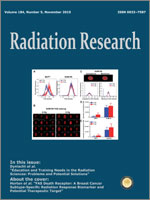Low-dose ionizing radiation is known to induce radioadaptive responses in cells in vitro as well as in mice in vivo. Low-dose radiation decreases the incidence and increases latency for spontaneous and radiation-induced tumors in mice, potentially as a result of enhanced cellular DNA repair efficiency or a reduction in genomic instability. In this study, the cytokinesis-block micronucleus (CBMN) assay was used to examine dose response and potential radioadaptive response for cytogenetic damage and cell survival in C57BL/6 and BALB/c spleen cells exposed in vitro or in vivo to low-dose 60Co gamma radiation. The effects of genetic background, radiation dose and dose rate, sampling time and cell cycle were investigated with respect to dose response and radioadaptive response. In C57BL/6 mice, a linear-quadratic dose-response relationship for the induction of micronuclei (MN) was observed for doses between 100 mGy and 2 Gy. BALB/c mice exhibited increased radiosensitivity for MN induction compared to C57BL/6 mice. A 20 mGy dose had no effect on MN frequencies in splenocytes of either mouse strain, however, increased spleen weight and a reduced number of dead cells were noted in the C57BL/6 strain only. Multiple experimental parameters were investigated in radioadaptive response studies, including dose and dose rate of the priming dose (20 mGy at 0.5 mGy/min and 100 mGy at 10 mGy/min), time interval (4 and 24 h) between priming and challenge doses, cell cycle stage (resting or proliferating) at exposure and kinetics after the challenge dose. Radioadaptive responses were not observed for MN induction for either mouse strain under any of the experimental conditions investigated. In contrast, a synergistic response for radiation-induced micronuclei in C57BL/6 spleen was detected after in vivo 20 mGy irradiation. This increase in the percentage of cells with cytogenetic damage was associated with a reduction in the number of nonviable spleen cells, suggesting that low-dose irradiation led to a reduction in the turnover of damaged cells within the spleen of C57BL/6 mice. Overall, these results indicate that long-term protective effects against tumor latency and other beneficial health outcomes observed after low-dose irradiation are not mediated by a reduction of the proportion of cells harboring radiation-induced cytogenetic damage.
How to translate text using browser tools
23 October 2015
Low-Dose Gamma Radiation Does Not Induce an Adaptive Response for Micronucleus Induction in Mouse Splenocytes
L. A. Bannister,
M. L. Serran,
R. R. Mantha
ACCESS THE FULL ARTICLE

Radiation Research
Vol. 184 • No. 5
November 2015
Vol. 184 • No. 5
November 2015




